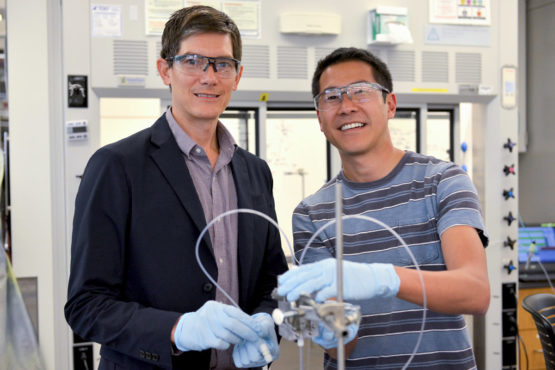
Stanford researchers Thomas Jaramillo, associate professor of chemical engineering and of photon science and Christopher Hahn, associate staff scientist at SLAC, recently innovated a renewable method of producing the fuel additive, ethanol. This method simply delivers water, carbon dioxide and electricity through a copper catalyst.
United States scientists’ common method of manufacturing ethanol uses miles of open terrain to produce fermented corn and other crops. Current agricultural workers use millions of acres of farmland to produce 14 million gallons of ethanol consumed yearly by drivers in the United States. Many automated vehicles operate on a mixture of gasoline and the fuel additive, ethanol.
Stanford researchers have created a substitute for the fuel-additive ethanol by modifying copper catalysts to produce ethanol using water and carbon dioxide. This innovation has enticed scientists and current state-of-the-art electrocatalysts will be improved in product selectivity and energy efficiency to make this alternative solution viable for the future.
In efforts to improve the catalyst’s production abilities for a more sustainable ethanol, researchers stated, “We show how the coordination environment of Cu surfaces influences oxygenate vs. hydrocarbon formation, providing insights on how to improve selectivity and energy efficiency toward more valuable CO2 reduction products.”
Thomas Jaramillo is a professor of chemical engineering at Stanford and a professor of photon science at the SLAC (Stanford Linear Accelerator Center) National Accelerator Laboratory. As the study’s chief investigator, Jaramillo states that one of their main goals is to produce a renewable type of ethanol that doesn’t damage the agricultural market internationally.
“Copper is one of the few catalysts that can produce ethanol at room temperature,” he said in a Stanford news report. “You just feed it electricity, water and carbon dioxide, and it makes ethanol. The problem is that it also makes 15 other compounds simultaneously, including lower-value products like methane and carbon monoxide. Separating those products would be an expensive process and require a lot of energy.”
Scientists hope to create copper catalysts that directly convert carbon dioxide into denser chemicals (such as propanol), with as little waste as possible. To create an innovative source with few byproducts, they must fully understand how the catalysts convert carbon dioxide into water.
Stanford scientists conducted a study with Proceedings of the National Academy of Sciences (PNAS) using three samples of crystalline copper: copper (100), copper (111) and copper (751) to describe the behavior of single crystals upon the surface.
“Copper (100), (111) and (751) look virtually identical but have major differences in the way their atoms are arranged on the surface,” said Christopher Hahn, an associate staff scientist at the Stanford Linear Accelerator Center and co-leader of the study to Stanford news reporter Mark Shwartz. “The essence of our work is to understand how these different facets of copper affect electrocatalytic performance.”
Researchers had produced copper electrodes with single-crystals but for this study, Hahn and his co-workers at SLAC discovered a new way to grow single crystal-like copper on top of silicon and sapphire. This innovation resulted in films of each form of copper with a 6-square centimeter surface, 600 times bigger than typical single crystals.
Copper (100), (111) and (751) proved to be the idealistic samples for a conversion into a renewable ethanol for cars and truck in the United States.
“The eye on the prize is to create better catalysts that have game-changing potential by taking carbon dioxide as a feedstock and converting it into much more valuable products using renewable electricity or sunlight directly,” Jaramillo said in a Stanford news article. “We plan to use this method on nickel and other metals to further understand the chemistry at the surface. We think this study is an important piece of the puzzle and will open up whole new avenues of research for the community.”
We necessitate fuel for our daily transportation and without a renewable source, in the near future, we wouldn’t be able to sustain our environment for further reproduction.
Electrocatalytic technology has the potential to impact climate change by enabling sustainable routes for the production of fuels and chemicals. If we are able to efficiently produce ethanol using these renewable sources (such as electricity), humankind would ascertain a prolonged future.
Contact Pratyusha Macherla at pmacherla09 ‘at’ gmail.com
